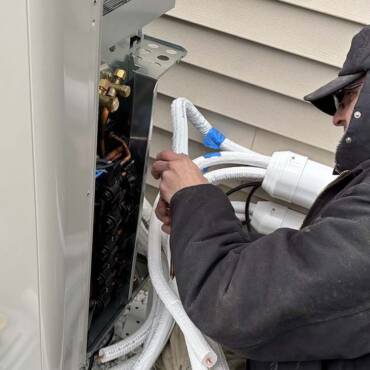5 Industry Tips Your HVAC Business Should Follow
Service-callbacks expenses plague the HVAC industry. Not only are you set to worrying about them for months after a job, but they’re most frequent during your busiest times of the year. As a business owner or manager, a bit of well-placed concern can help you prepare and train for callbacks. Of course, ultimately reducing callbacks is the goal.
1. Don’t Assume a Call is a Callback
There are technical callbacks, neglect callbacks, and then there are simply complaints. Yes, if a person does call back after a service, it will cost some of your businesses time. However, that doesn’t mean that they should automatically have their fee waived. Create a distinct outline of what you will and won’t cover as part of a callback when waiving fees. Then, always wait for your service person to make a clear assessment on the job site.
This tip applies explicitly to your administrative staff. Put CRM software to work for you and ensure that customer service reps or other’s taking call from customers reference the system before deciding that the next visit is free. When training administrative staff take time to explain the nuances of determining if the request resulted because of failure, oversight, or neglect on the technician’s part.
2. Carefully Decide Which Technician to Send on the Callback
 It’s a hot topic within the HVAC industry. Some argue that sending the same technician out will only frustrate the customer. However, there are often situations where that technician built rapport and could help the customer through an irritating job.
It’s a hot topic within the HVAC industry. Some argue that sending the same technician out will only frustrate the customer. However, there are often situations where that technician built rapport and could help the customer through an irritating job.
For technical callbacks where something isn’t working quite right, send the same technician. Give them a chance to explain to the homeowner why the first repair didn’t have the desired result. A defective part or a part which burned out after installation is something that would have happened regardless of who installed it.
For neglect callbacks, send a different technician. You never want to put your service people in a bad position, and neglect callbacks are more likely to come from upset customers. Always send the technician with the most training and the most reliable track record.
All of your technicians should receive training in defusing tense situations. Callbacks come with a degree of frustration for everyone involved. Your techs are the ones who can step in, be personable, and explain the solution rather than letting the customer dwell on the problem.
Role play during training is difficult for people to take seriously. Instead, have new technicians ride along with experienced staff members to a few callbacks so they can see how a professional handles these situations.
3. Create Walk-through Programs for Your Staff
Tools left in houses, screws left on counters, and some times, outright neglected are all issues that come up in callbacks. Why? Your technician is in the middle of one repair while they receive notice that they’ll be having additional calls put onto their day. That you can’t change. But you can make it easy for them to observe the scene and correct anything left undone immediately quickly.
Use a checklist and load it into your mobile platform. You can make checklists available through OneNote, Trello, Basecamp, and various management programs. Be sure that you include straightforward things on your list such as “collected all tools brought into the home.”
4. Use Callbacks as a Training Opportunity
Your callbacks are likely coming from specific technicians. They may be new, or they may work too quickly, they may even be merely forgetful. The thing to keep in mind here is that callbacks should only happen on very rare occasions. When they frequently occur for the same person, then there is an issue.
Assign pieces of training to your technicians based on the premise of the callback. If someone failed to close off access points, or left areas loose, which led to noises, you could assign training programs for the importance of safety. In the short term, this will cost you money as a training expense. In the long term, it will save you because technicians will become more careful. Not only will the training exercises kick in, but they’ll want to avoid having to repeat training in the future.
5. Train Your HVAC Technicians to Look Past the Problem
No doubt you have received callbacks with a complaint that the technician should have found this outlying problem while they were servicing the unit. The keynote there is should have, and in some sense the customer is right. Although you tech didn’t do anything wrong, they didn’t report that other things might disrupt the service or functioning of the unit. Now the property or homeowner is frustrated because they have to schedule another repair, and they usually don’t want to pay for another diagnosis.
When your technician goes out to make the repair, or preferably, make a diagnosis, they should look past the immediate problem. If at all possible, when they’re done with their repair or installment, they should watch the unit function for a short stint of time and report any irregularities. Similar to medical professionals, HVAC technicians can find 1,000 things wrong with something even when there are only mild symptoms present.
Use training to educate your technicians on “Additional-Work-Required” reports, or AWR reports. These reports allow them to list everything that could potentially lead to future problems, or that may contribute to the current issue.
For example, a technician noticing a contractor is in poor shape, or that a fan is cycling differently than it should, they should note that on an AWR report. However, you should make it clear during the training process that you’re not trying to upsell unnecessary repairs. The process of an AWR report is to minimize callbacks. Rather than this customer making a callback with the complain that they didn’t know about this other problem, they can choose to schedule the repair or not.
Usually, AWR reports give customers a window to act, such as 30 days. If the customer doesn’t respond within that time frame, then when they do call to schedule that repair it is clearly not a callback.
Communicate with Your Staff
Your training program is an opportunity to set expectations, build habits, and stave off unwanted behavior. Don’t treat your program as a one-time event. Instead, have technicians with callbacks revisit vital areas of training. Create an additional training course on how to properly use AWR reports, and when to file them to reduce callbacks. Finally, set clear expectations with your training and provide follow-up materials such as checklists or walkthrough instructions for your staff to use on job sites.
Whether you require installation, repair, or maintenance, our technicians will assist you with top-quality service at any time of the day or night. Take comfort in knowing your indoor air quality is the best it can be with MOE heating & cooling services Ontario's solution for heating, air conditioning, and ventilation that’s cooler than the rest.
Contact us to schedule a visit. Our qualified team of technicians, are always ready to help you and guide you for heating and cooling issues. Weather you want to replace an old furnace or install a brand new air conditioner, we are here to help you. Our main office is at Kitchener but we can service most of Ontario's cities
Source link



Add Comment